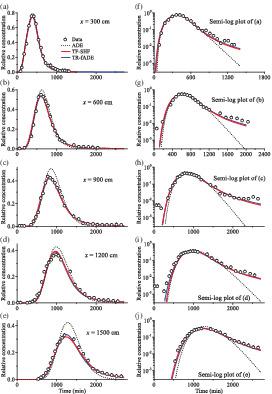当前位置:
X-MOL 学术
›
Hydrol. Process.
›
论文详情
Our official English website, www.x-mol.net, welcomes your
feedback! (Note: you will need to create a separate account there.)
Nonlocal transport models for capturing solute transport in one‐dimensional sand columns: Model review, applicability, limitations and improvement
Hydrological Processes ( IF 2.8 ) Pub Date : 2020-10-08 , DOI: 10.1002/hyp.13930 Yong Zhang 1 , Dongbao Zhou 2 , Maosheng Yin 3 , HongGuang Sun 2 , Wei Wei 4 , Shiyin Li 4 , Chunmiao Zheng 5
Hydrological Processes ( IF 2.8 ) Pub Date : 2020-10-08 , DOI: 10.1002/hyp.13930 Yong Zhang 1 , Dongbao Zhou 2 , Maosheng Yin 3 , HongGuang Sun 2 , Wei Wei 4 , Shiyin Li 4 , Chunmiao Zheng 5
Affiliation

|
Modelling pollutant transport in water is one of the core tasks of computational hydrology, and various physical models including especially the widely used nonlocal transport models have been developed and applied in the last three decades. No studies, however, have been conducted to systematically assess the applicability, limitations and improvement of these nonlocal transport models. To fill this knowledge gap, this study reviewed, tested and improved the state‐of‐the‐art nonlocal transport models, including their physical background, mathematical formula and especially the capability to quantify conservative tracers moving in one‐dimensional sand columns, which represents perhaps the simplest real‐world application. Applications showed that, surprisingly, neither the popular time‐nonlocal transport models (including the multi‐rate mass transfer model, the continuous time random walk framework and the time fractional advection‐dispersion equation), nor the spatiotemporally nonlocal transport model (ST‐fADE) can accurately fit passive tracers moving through a 15‐m‐long heterogeneous sand column documented in literature, if a constant dispersion coefficient or dispersivity is used. This is because pollutant transport in heterogeneous media can be scale‐dependent (represented by a dispersion coefficient or dispersivity increasing with spatiotemporal scales), non‐Fickian (where plume variance increases nonlinearly in time) and/or pre‐asymptotic (with transition between non‐Fickian and Fickian transport). These different properties cannot be simultaneously and accurately modelled by any of the transport models reviewed by this study. To bypass this limitation, five possible corrections were proposed, and two of them were tested successfully, including a time fractional and space Hausdorff fractal model which minimizes the scale‐dependency of the dispersion coefficient in the non‐Euclidean space, and a two‐region time fractional advection‐dispersion equation which accounts for the spatial mixing of solute particles from different mobile domains. Therefore, more efforts are still needed to accurately model transport in non‐ideal porous media, and the five model corrections proposed by this study may shed light on these indispensable modelling efforts.
中文翻译:

用于捕获一维砂柱中溶质运移的非本地运移模型:模型审查,适用性,局限性和改进
模拟水中的污染物迁移是计算水文学的核心任务之一,并且在过去的三十年中已经开发并应用了各种物理模型,尤其是广泛使用的非本地迁移模型。但是,尚未进行任何研究来系统地评估这些非本地运输模型的适用性,局限性和改进之处。为了填补这一知识空白,本研究回顾,测试和改进了最新的非本地运输模型,包括其物理背景,数学公式,尤其是对在一维砂柱中移动的保守示踪剂进行定量的能力,这代表了也许是最简单的现实应用程序。应用表明,令人惊讶的是,流行的非局部时空传输模型(包括多速率传质模型,连续时间随机游走框架和时间分数对流扩散方程)和时空非局部时空传输模型(ST-fADE)都无法准确地拟合被动示踪剂如果使用恒定的弥散系数或弥散系数,则将其移动通过文献中记载的15米长的异质砂柱。这是因为污染物在非均质介质中的迁移可能是尺度相关的(由分散系数或分散性随时空尺度增加表示),非菲克(羽状方差随时间非线性地增加)和/或渐近前(非零之间的过渡)。 -Fickian和Fickian运输)。这些不同的属性不能通过本研究回顾的任何运输模型同时且准确地建模。为了避免这种局限性,提出了五种可能的校正方法,并成功地测试了其中两种,包括时间分数和空间Hausdorff分形模型,该模型最小化了非欧几里德空间中色散系数的比例依赖性,并采用了两个区域时间分数对流扩散方程,说明了来自不同移动域的溶质颗粒的空间混合。因此,仍然需要付出更多的努力来准确地模拟非理想多孔介质中的传输,并且这项研究提出的五种模型修正可能会为这些必不可少的建模工作提供启示。其中两个成功进行了测试,包括一个时间分数和空间的Hausdorff分形模型,该模型使非欧空间中的弥散系数的比例依赖性最小,以及一个考虑了空间的两区域时间分数对流-弥散方程混合来自不同移动域的溶质颗粒。因此,仍然需要付出更多的努力来准确地模拟非理想多孔介质中的传输,并且本研究提出的五种模型修正可能会为这些必不可少的建模工作提供启示。他们中的两个成功进行了测试,包括时间分数和空间Hausdorff分形模型,该模型使非欧空间中的色散系数在比例上的相关性最小,以及一个考虑了空间分布的两区域时间分数对流扩散方程混合来自不同移动域的溶质颗粒。因此,仍然需要付出更多的努力来准确地模拟非理想多孔介质中的传输,并且本研究提出的五种模型修正可能会为这些必不可少的建模工作提供启示。以及一个两区域时间分数对流扩散方程,该方程解释了来自不同移动域的溶质颗粒的空间混合。因此,仍然需要付出更多的努力来准确地模拟非理想多孔介质中的传输,并且本研究提出的五种模型修正可能会为这些必不可少的建模工作提供启示。以及一个两区域时间分数对流扩散方程,该方程解释了来自不同移动域的溶质颗粒的空间混合。因此,仍然需要付出更多的努力来准确地模拟非理想多孔介质中的传输,并且本研究提出的五种模型修正可能会为这些必不可少的建模工作提供启示。
更新日期:2020-12-10
中文翻译:

用于捕获一维砂柱中溶质运移的非本地运移模型:模型审查,适用性,局限性和改进
模拟水中的污染物迁移是计算水文学的核心任务之一,并且在过去的三十年中已经开发并应用了各种物理模型,尤其是广泛使用的非本地迁移模型。但是,尚未进行任何研究来系统地评估这些非本地运输模型的适用性,局限性和改进之处。为了填补这一知识空白,本研究回顾,测试和改进了最新的非本地运输模型,包括其物理背景,数学公式,尤其是对在一维砂柱中移动的保守示踪剂进行定量的能力,这代表了也许是最简单的现实应用程序。应用表明,令人惊讶的是,流行的非局部时空传输模型(包括多速率传质模型,连续时间随机游走框架和时间分数对流扩散方程)和时空非局部时空传输模型(ST-fADE)都无法准确地拟合被动示踪剂如果使用恒定的弥散系数或弥散系数,则将其移动通过文献中记载的15米长的异质砂柱。这是因为污染物在非均质介质中的迁移可能是尺度相关的(由分散系数或分散性随时空尺度增加表示),非菲克(羽状方差随时间非线性地增加)和/或渐近前(非零之间的过渡)。 -Fickian和Fickian运输)。这些不同的属性不能通过本研究回顾的任何运输模型同时且准确地建模。为了避免这种局限性,提出了五种可能的校正方法,并成功地测试了其中两种,包括时间分数和空间Hausdorff分形模型,该模型最小化了非欧几里德空间中色散系数的比例依赖性,并采用了两个区域时间分数对流扩散方程,说明了来自不同移动域的溶质颗粒的空间混合。因此,仍然需要付出更多的努力来准确地模拟非理想多孔介质中的传输,并且这项研究提出的五种模型修正可能会为这些必不可少的建模工作提供启示。其中两个成功进行了测试,包括一个时间分数和空间的Hausdorff分形模型,该模型使非欧空间中的弥散系数的比例依赖性最小,以及一个考虑了空间的两区域时间分数对流-弥散方程混合来自不同移动域的溶质颗粒。因此,仍然需要付出更多的努力来准确地模拟非理想多孔介质中的传输,并且本研究提出的五种模型修正可能会为这些必不可少的建模工作提供启示。他们中的两个成功进行了测试,包括时间分数和空间Hausdorff分形模型,该模型使非欧空间中的色散系数在比例上的相关性最小,以及一个考虑了空间分布的两区域时间分数对流扩散方程混合来自不同移动域的溶质颗粒。因此,仍然需要付出更多的努力来准确地模拟非理想多孔介质中的传输,并且本研究提出的五种模型修正可能会为这些必不可少的建模工作提供启示。以及一个两区域时间分数对流扩散方程,该方程解释了来自不同移动域的溶质颗粒的空间混合。因此,仍然需要付出更多的努力来准确地模拟非理想多孔介质中的传输,并且本研究提出的五种模型修正可能会为这些必不可少的建模工作提供启示。以及一个两区域时间分数对流扩散方程,该方程解释了来自不同移动域的溶质颗粒的空间混合。因此,仍然需要付出更多的努力来准确地模拟非理想多孔介质中的传输,并且本研究提出的五种模型修正可能会为这些必不可少的建模工作提供启示。











































 京公网安备 11010802027423号
京公网安备 11010802027423号